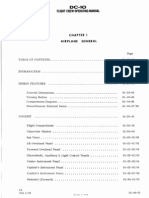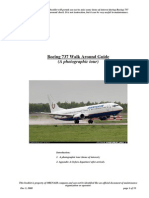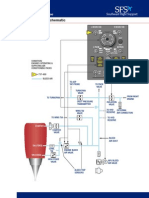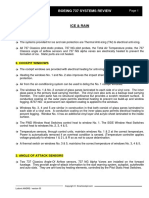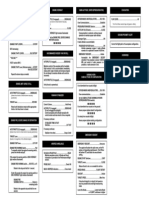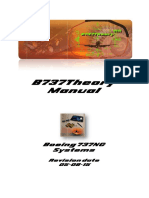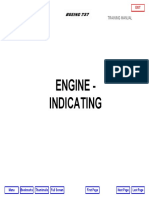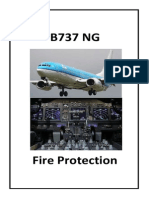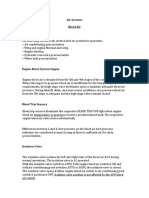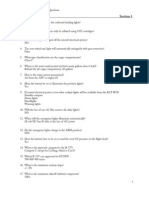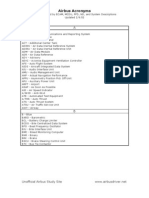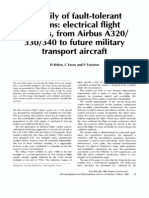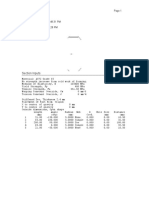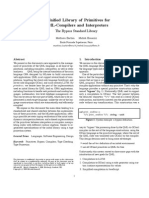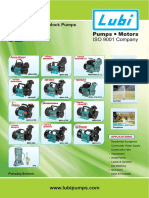01 General B737-NG
01 General B737-NG
Uploaded by
Leilani OrtegaCopyright:
Available Formats
01 General B737-NG
01 General B737-NG
Uploaded by
Leilani OrtegaOriginal Description:
Copyright
Available Formats
Share this document
Did you find this document useful?
Is this content inappropriate?
Copyright:
Available Formats
01 General B737-NG
01 General B737-NG
Uploaded by
Leilani OrtegaCopyright:
Available Formats
TRAINING MANUAL
B737-NG GENERAL
EXIT
Bookmarks First Page Next Page Last Page Thumbnails Menu Full Screen
TRAINING MANUAL
737 GENERAL INTRODUCTION
Introduction
This section introduces you to the 737700/800/900
airplane.
You will see general information about these topics:
Range
Dimensions
Engines
Flight controls
Doors
Flight compartment panels
Electronic equipment rack configuration
Electrical.
Abbreviations and Acronyms
A/P autopilot
A/S airspeed
ac alternate current
ACARS ARINC communications addressing and
reporting system
ACMS airplane condition monitoring system
ADF automatic direction finder
ADIRS air data inertial reference system
AFCS automatic flight control system
EFFECTIVITY
AGCU APU generator control unit
altn alternate
amp amplifier
APB APU breaker
APU auxiliary power unit
ATC air traffic control
att attendant
auto automatic
bat battery
bcn beacon
BL buttock line
BPCU bus power control unit
BTB bus tie breaker
C/W control wheel
capt captain
CDS common display system
CDU control display unit
chgr charger
comm communication
comp computer
conn connected
cond condition
cntl control
det detector
DEU display electronic unit
dist distribution
000000
2
EXIT
Bookmarks First Page Prev Page Next Page Last Page Thumbnails Menu Full Screen
TRAINING MANUAL
737 GENERAL INTRODUCTION
DME distance measuring equipment
DU display unit
ECU electronic control unit
EE electronic equipment
EEC electronic engine control
elex electronics
ELT emergency locator transmitter
EMDP electric motor driven pump
ESDS electrostatic discharge sensitive
ext external
F/O first officer
FCC flight control computer
FMC flight management computer
FMCS flight management computer system
freq frequency
fwd forward
GCU generator control unit
gnd ground
GPS global positioning system
HF high frequency
HUD heads up display
IDG integrated drive generator
ILS instrument landing system
inv inverter
L left
LBL left buttock line
LE leading edge
LRRA low range radio altimeter
LRU line replaceable unit
mod module
MLG main landing gear
MCP mode control panel
MPD maintenance planning document
nav navigation
NLG nose landing gear
ovht overheat
PA passenger address
PCU power control unit
PDP power distribution panel
pnl panel
prox proximity
PSU passenger service unit
pwr power
R right
RBL right buttock line
REU remote electronics unit
RLY relay
SATCOM satellite communication
S/B speedbrake
000000
3
EFFECTIVITY
EXIT
Bookmarks First Page Prev Page Next Page Last Page Thumbnails Menu Full Screen
TRAINING MANUAL
737 GENERAL INTRODUCTION
sec section
sel select
SCU start converter unit
SPU start power unit
SOV shutoff valve
stab stabilizer
STA station
stdby standby
sw switch
TCAS traffic alert and collision avoidance
system
TE trailing edge
TRU transformer rectifier unit
typ typical
VHF very high frequency
vlv valve
VOR VHF omni range
WL water line
xfer transfer
xfmr transformer
000000
4
EFFECTIVITY
EXIT
Bookmarks First Page Prev Page Next Page Last Page Thumbnails Menu Full Screen
TRAINING MANUAL
EFFECTIVITY
737 GENERAL INTRODUCTION
000000
5
EXIT
Bookmarks First Page Prev Page Next Page Last Page Thumbnails Menu Full Screen
TRAINING MANUAL
737 GENERAL RANGE
Introduction
The 737700 is a twoengine airplane. It is for short to
medium range flights with a capacity of up to 149
passengers. The 737-900 has a capacity of up to 189
passengers.
Features
There are many new features. These new features
increase the airplane payload, service ceiling, and
range.
The 700 airplane has a design range of 3,200 nautical
miles. The 900 has a design range of 2,745 nautical
miles.
000000
6
EFFECTIVITY
EXIT
Bookmarks First Page Prev Page Next Page Last Page Thumbnails Menu Full Screen
TRAINING MANUAL
EFFECTIVITY
B737-900
B737-800
B737-700
737 GENERAL RANGE
000000
7
EXIT
Bookmarks First Page Prev Page Next Page Last Page Thumbnails Menu Full Screen
TRAINING MANUAL
737 GENERAL STRUCTURE DIMENSIONS
General
These are the general dimensions of the airplane.
000000
8
EFFECTIVITY
EXIT
Bookmarks First Page Prev Page Next Page Last Page Thumbnails Menu Full Screen
TRAINING MANUAL
000000
9
EFFECTIVITY
737 GENERAL STRUCTURE DIMENSIONS
EXIT
Bookmarks First Page Prev Page Next Page Last Page Thumbnails Menu Full Screen
TRAINING MANUAL
737 GENERAL FUSELAGE DIMENSIONS
General
Dimensions give locations on the fuselage. The scale
for each dimension is inches. You use these
dimensions to find components on the fuselage:
Body station line
Body buttock line
Water line.
The body station line (STA) is a horizontal dimension. It
starts at station line zero. You measure the body
station line from a vertical reference plane that is
forward of the airplane.
The body buttock line (BL) is a lateral dimension. You
measure the buttock line to the left or right of the
airplane center line.
The water line (WL) is a height dimension. You measure
the water line from a horizontal reference plane below the
airplane.
000000
10
EFFECTIVITY
EXIT
Bookmarks First Page Prev Page Next Page Last Page Thumbnails Menu Full Screen
TRAINING MANUAL
000000
11
EFFECTIVITY
737 GENERAL FUSELAGE DIMENSIONS
EXIT
Bookmarks First Page Prev Page Next Page Last Page Thumbnails Menu Full Screen
TRAINING MANUAL
737 GENERAL POWER PLANT INTRODUCTION
General
Two CFM567B engines supply thrust for the airplane.
The engines also supply power for these systems:
Electric
Hydraulic
Pneumatic.
The CFM567B is a high bypass ratio, dual rotor, turbo
fan engine.
000000
12
EFFECTIVITY
EXIT
Bookmarks First Page Prev Page Next Page Last Page Thumbnails Menu Full Screen
TRAINING MANUAL
000000
13
EFFECTIVITY
737 GENERAL POWER PLANT INTRODUCTION
EXIT
Bookmarks First Page Prev Page Next Page Last Page Thumbnails Menu Full Screen
TRAINING MANUAL
737 GENERAL POWER PLANT ENGINE HAZARDS
General
It is dangerous to work around engines. Use the
entry/exit corridor when the engine is in operation. Stay
out of the inlet and exhaust areas when the engine is in
operation.
These are the hazards around an engine in operation:
Inlet suction
Exhaust heat
Exhaust velocity
Engine noise.
Inlet Suction
Engine inlet suction can pull people and large objects
into the engine. At idle power, the inlet hazard area is a
13 ft (4.0 m) radius around the inlet.
WARNING: IF THE WIND IS OVER 25 KNOTS,
INCREASE THE INLET HAZARD AREA BY
20%.
Exhaust Heat
The engine exhaust is very hot for a long distance
behind the engine. This can cause damage to
personnel and equipment.
Exhaust Velocity
Exhaust velocity is very high for a long distance behind
the engine. This can cause damage to personnel and
equipment.
Engine Noise
Engine noise can cause temporary and permanent loss
of your ability to hear. You must wear ear protection
when near an engine in operation.
Engine Entry/Exit Corridor
Engine entry corridors are between the inlet hazard
areas and the exhaust hazard areas. You should go
near an engine in operation only when:
The engine is at idle
You can speak with people in the flight
compartment.
For additional safety, wear a safety harness when the
engine is in operation.
Training Information Point
When the engine is in operation, the anticollision lights
should be on.
000000
14
EFFECTIVITY
EXIT
Bookmarks First Page Prev Page Next Page Last Page Thumbnails Menu Full Screen
TRAINING MANUAL
000000
15
EFFECTIVITY
737 GENERAL POWER PLANT ENGINE HAZARDS
EXIT
Bookmarks First Page Prev Page Next Page Last Page Thumbnails Menu Full Screen
TRAINING MANUAL
737 GENERAL FLIGHT CONTROL SURFACES
General
The flight controls keep the airplane at the necessary
attitude during flight. They have movable surfaces on
the wing and the empennage. These are the two types
of flight controls:
Primary
Secondary.
Primary Flight Controls
The primary flight controls has these components:
Aileron (2)
Elevator (2)
Rudder.
Secondary Flight Controls
The secondary flight control system has these
components:
Leading edge flaps (4)
Leading edge slats (8)
Trailing edge flaps (4)
Spoilers (12)
Horizontal stabilizer.
The 12 spoilers consists of ground and flight spoilers.
The spoilers are numbered 1 to 12, left to right.
Power Source
Hydraulic actuators or electric motors move the surfaces.
You must be very careful when you work near flight
control surfaces. When hydraulic power is on, make sure
that all the flight control surfaces are clear of personnel
and equipment.
000000
16
EFFECTIVITY
EXIT
Bookmarks First Page Prev Page Next Page Last Page Thumbnails Menu Full Screen
TRAINING MANUAL
000000
17
EFFECTIVITY
737 GENERAL FLIGHT CONTROL SURFACES
EXIT
Bookmarks First Page Prev Page Next Page Last Page Thumbnails Menu Full Screen
TRAINING MANUAL
737 GENERAL DOORS INTRODUCTION
Purpose
The doors are movable units that give access to the
airplane compartments.
General Description
These are the types of doors on the airplane:
Forward and aft entry doors
Forward and aft galley service doors
Emergency exit hatches (and pilots' sliding
windows)
Cargo doors
Interior doors (crew door and lavatory doors)
Miscellaneous access doors.
Location
The entry doors are on the left side of the airplane.
The galley service doors are on the right side of the
airplane.
The emergency exit hatches are above the wings on
both sides of the airplane. The pilots' sliding windows
are in the flight compartment.
The crew door and lavatory doors are inside the
airplane.
EFFECTIVITY
The cargo doors are on the right side of the airplane.
The miscellaneous access doors are near the systems
they serve.
Training Information Point
You can open and close entry, galley service, and
cargo doors in winds up to 40 knots without structural
damage. You can let these doors stay latched open in
winds up to 65 knots without structural damage.
If a door is left open for a long time, a protective cover
should be put over the door frame. This prevents bad
weather damage to the airplane.
000000
18
EXIT
Bookmarks First Page Prev Page Next Page Last Page Thumbnails Menu Full Screen
TRAINING MANUAL
000000
19
EFFECTIVITY
737 GENERAL DOORS INTRODUCTION
EXIT
Bookmarks First Page Prev Page Next Page Last Page Thumbnails Menu Full Screen
TRAINING MANUAL
737 GENERAL - FLIGHT COMPARTMENT PANELS
Flight Compartment Panels
These are the major panels in the flight compartment:
- P1 captain instrument panel
- P2 center instrument panel
- P5 forward overhead panel
- P5 aft overhead panel
- P7 glareshield panel
- P3 first officer instrument panel
- P9 forward electronic panel
- Control stand
- P8 aft electronic panel.
000000
20
EFFECTIVITY
EXIT
Bookmarks First Page Prev Page Next Page Last Page Thumbnails Menu Full Screen
TRAINING MANUAL
000000
21
EFFECTIVITY
737 GENERAL - FLIGHT COMPARTMENT PANELS
EXIT
Bookmarks First Page Prev Page Next Page Last Page Thumbnails Menu Full Screen
TRAINING MANUAL
737 GENERAL MAIN INSTRUMENT PANELS
General
The controls and displays on the main instrument
panels (P1 and P3) include these components:
Clock (2)
Display unit (4)
Display select panel (2)
Master dim and test switch
Brake pressure indicator
Autoflight status annunciator (2)
GPWS control panel
Lighting control (2)
Conditioned air outlet control (2).
000000
22
EFFECTIVITY
EXIT
Bookmarks First Page Prev Page Next Page Last Page Thumbnails Menu Full Screen
TRAINING MANUAL
000000
23
EFFECTIVITY
737 GENERAL MAIN INSTRUMENT PANELS - 1
EXIT
Bookmarks First Page Prev Page Next Page Last Page Thumbnails Menu Full Screen
TRAINING MANUAL
000000
24
EFFECTIVITY
737 GENERAL MAIN INSTRUMENT PANELS - 2
EXIT
Bookmarks First Page Prev Page Next Page Last Page Thumbnails Menu Full Screen
TRAINING MANUAL
EFFECTIVITY
TRAINING MANUAL
000000
25
EFFECTIVITY
000000
25
EXIT
Bookmarks First Page Prev Page Next Page Last Page Thumbnails Menu Full Screen
TRAINING MANUAL
EFFECTIVITY
TRAINING MANUAL
000000
26
EFFECTIVITY
000000
26
EXIT
Bookmarks First Page Prev Page Next Page Last Page Thumbnails Menu Full Screen
TRAINING MANUAL
EFFECTIVITY
TRAINING MANUAL
000000
27
EFFECTIVITY
000000
27
EXIT
Bookmarks First Page Prev Page Next Page Last Page Thumbnails Menu Full Screen
TRAINING MANUAL
EFFECTIVITY
TRAINING MANUAL
000000
28
EFFECTIVITY
000000
28
EXIT
Bookmarks First Page Prev Page Next Page Last Page Thumbnails Menu Full Screen
TRAINING MANUAL
EFFECTIVITY
TRAINING MANUAL
000000
29
EFFECTIVITY
000000
29
EXIT
Bookmarks First Page Prev Page Next Page Last Page Thumbnails Menu Full Screen
TRAINING MANUAL
737 GENERAL GLARESHIELD PANELS
General
The controls and displays on the P7 glareshield include
these components:
Master caution annunciator (2)
System caution annunciator (2)
Mode control panel (MCP)
EFIS control panel (2)
Fire warning light (2)
000000
30
EFFECTIVITY
EXIT
Bookmarks First Page Prev Page Next Page Last Page Thumbnails Menu Full Screen
TRAINING MANUAL
000000
31
EFFECTIVITY
737 GENERAL GLARESHIELD PANELS
EXIT
Bookmarks First Page Prev Page Next Page Last Page Thumbnails Menu Full Screen
TRAINING MANUAL
737 GENERAL P2 CENTER INSTRUMENT PANEL
AND P9 FORWARD ELECTRONICS PANEL
General
The controls and displays on the P2 center instrument
panel include these components:
Yaw damper indicator
Standby instruments
Engine display control panel
Antiskid and autobrake switches and lights
Flap position indicator
Landing gear lever and position indicator
Upper center display unit.
The controls and displays on the P9 forward electronics
panel include these components:
Lower center display unit
Control display unit (CDU) (2).
000000
32
EFFECTIVITY
EXIT
Bookmarks First Page Prev Page Next Page Last Page Thumbnails Menu Full Screen
TRAINING MANUAL
000000
33
EFFECTIVITY
737 GENERAL P2 CENTER INSTRUMENT PANEL AND P9 FORWARD
EXIT
Bookmarks First Page Prev Page Next Page Last Page Thumbnails Menu Full Screen
TRAINING MANUAL
737 GENERAL CONTROL STAND
GENERAL
The controls and indicators on the control stand include
these components:
Forward thrust lever (2)
Reverse thrust lever (2)
Speed brake handle
Horizontal stabilizer trim wheel and indicator (2)
Parking brake lever and indication light
Flap lever
Stabilizer trim cutout switch (2)
Start lever (2).
000000
34
EFFECTIVITY
EXIT
Bookmarks First Page Prev Page Next Page Last Page Thumbnails Menu Full Screen
TRAINING MANUAL
000000
35
EFFECTIVITY
737 GENERAL CONTROL STAND
EXIT
Bookmarks First Page Prev Page Next Page Last Page Thumbnails Menu Full Screen
TRAINING MANUAL
737 GENERAL P8 AFT ELECTRONICS PANEL
General
The P8 aft electronics panel has these components:
Weather radar control panel
Overheat/fire protection panel
ATC/TCAS control panel
Radio communication panels
Navigation control panels
Audio control panels
Aileron/rudder trim panel
ACMS printer
Lighting control.
000000
36
EFFECTIVITY
EXIT
Bookmarks First Page Prev Page Next Page Last Page Thumbnails Menu Full Screen
TRAINING MANUAL
EFFECTIVITY
737 GENERAL P8 AFT ELECTRONICS PANEL
000000
37
EXIT
Bookmarks First Page Prev Page Next Page Last Page Thumbnails Menu Full Screen
TRAINING MANUAL
737 GENERAL P5 AFT OVERHEAD PANEL
General
The controls and displays on the P5 aft overhead panel
include these components:
Inertial system display unit
Engine panel
Observer audio control panel
Oxygen panel
Landing gear indicator lights
White dome light switch
Service interphone switch
IRS mode select unit
Proximity switch electronics unit light
Leading edge devices annunciator panel.
000000
38
EFFECTIVITY
EXIT
Bookmarks First Page Prev Page Next Page Last Page Thumbnails Menu Full Screen
TRAINING MANUAL
000000
39
EFFECTIVITY
737 GENERAL P5 AFT OVERHEAD PANEL
EXIT
Bookmarks First Page Prev Page Next Page Last Page Thumbnails Menu Full Screen
TRAINING MANUAL
737 GENERAL P5 FORWARD OVERHEAD PANEL
General
The controls and displays on the P5 forward overhead
panel include these components:
APU control switch
APU indicator panel
Fuel control panel
Ground power and bus switching panel
Equipment cooling panel
Generator drive and standby power panel
AC and DC meter panel
Flight control panel
Airconditioning/bleed air controls panel
Hydraulic control panel
Cabin altitude panel
Cabin pressure control panel
Engine start panel.
000000
40
EFFECTIVITY
EXIT
Bookmarks First Page Prev Page Next Page Last Page Thumbnails Menu Full Screen
TRAINING MANUAL
000000
41
EFFECTIVITY
737 GENERAL P5 FORWARD OVERHEAD PANEL - 700
CAL 701+
EXIT
Bookmarks First Page Prev Page Next Page Last Page Thumbnails Menu Full Screen
TRAINING MANUAL
EFFECTIVITY
737 GENERAL P5 FORWARD OVERHEAD PANEL 800/900
000000
42
CAL 201+; 401+
EXIT
Bookmarks First Page Prev Page Next Page Last Page Thumbnails Menu Full Screen
TRAINING MANUAL
737 GENERAL AFT FLIGHT COMPARTMENT
PANELS
General
The main circuit breaker panels are behind the first
officer and captain seats. The P6 and P18 have the
component load circuit breakers. Circuit breakers are
organized by airplane systems.
The P61 panel has the data loader controls.
000000
43
EFFECTIVITY
EXIT
Bookmarks First Page Prev Page Next Page Last Page Thumbnails Menu Full Screen
TRAINING MANUAL
000000
44
EFFECTIVITY
737 GENERAL AFT FLIGHT COMPARTMENT
EXIT
Bookmarks First Page Prev Page Next Page Last Page Thumbnails Menu Full Screen
TRAINING MANUAL
737 GENERAL ELECTRONIC EQUIPMENT
COMPARTMENT
General
Electronic equipment is in a compartment below the
main cabin floor, aft of the nose wheel well. On the
ground, you enter this electronic equipment (EE)
compartment through a door in the bottom of the
fuselage. The door is just aft of the nose landing gear.
There are five standard equipment racks. These are
the E1, E2, E3, E4, and E5 racks.
Shelf assemblies have equipment mounts,
interconnected wiring, and accessory boxes. Most
equipment rack shelves are cooled with air. Air is blown
through or drawn through the equipment racks.
There is a drip shield over the racks to protect the
equipment from moisture condensation.
000000
45
EFFECTIVITY
EXIT
Bookmarks First Page Prev Page Next Page Last Page Thumbnails Menu Full Screen
TRAINING MANUAL
000000
46
EFFECTIVITY
737 GENERAL ELECTRONIC EQUIPMENT COMPARTMENT
EXIT
Bookmarks First Page Prev Page Next Page Last Page Thumbnails Menu Full Screen
TRAINING MANUAL
737 GENERAL EE COMPARTMENT DOOR
OPERATION
Operation
You manually operate an external access door to the
electronic equipment (EE) compartment. You open and
close the door from outside the airplane.
Open Door
The handle on the door fairs in a recess. A push
button trigger releases the handle, and it comes out of
fair by spring force.
Turn the handle counterclockwise to disengage the
latch pins. When the latch pins are free you can push
the door upward and slightly to the right to the first
detent. Then push the door to the right to the fully open
detent.
When the door is fully open, the roller tracks can be
folded to improve access to the equipment racks. A
spring catch on the end of each roller track holds the
track in the folded or unfolded position.
Close Door
Before you close the door, release the spring catch and
extend the roller tracks. Make sure the door frame area
is clear.
EFFECTIVITY
Pull the door out of the fully open detent and then
restrain it as gravity causes it to slide down the tracks.
When the door reaches the lower detent you can
release it.
Turn the handle counterclockwise to retract the latch
pins. If you do not do this, the door will not seat in the
door frame.
Pull the handle to the left and the door will come out of
the partially open detent. Then it slides down into the
door frame.
Turn the handle clockwise to latch the door. Then push
the door handle back into its recess.
000000
47
EXIT
Bookmarks First Page Prev Page Next Page Last Page Thumbnails Menu Full Screen
TRAINING MANUAL
000000
48
EFFECTIVITY
737 GENERAL EE COMPARTMENT DOOR OPERATION
EXIT
Bookmarks First Page Prev Page Next Page Last Page Thumbnails Menu Full Screen
TRAINING MANUAL
737 GENERAL ELECTRONIC EQUIPMENT RACK
E1
General
The equipment on the E1 rack includes electronics for
these functions:
Autothrottle
Autopilot
Communication
Navigation
Flight control.
000000
49
EFFECTIVITY
EXIT
Bookmarks First Page Prev Page Next Page Last Page Thumbnails Menu Full Screen
TRAINING MANUAL
PROGRAM SWITCH
MODULE (TYP)
000000
50
EFFECTIVITY
737 GENERAL ELECTRONIC EQUIPMENT RACK E1
EXIT
Bookmarks First Page Prev Page Next Page Last Page Thumbnails Menu Full Screen
TRAINING MANUAL
737 GENERAL PROGRAM SWITCH MODULE
General
Many of the line replaceable units (LRUs) are
controlled by internal digital computers. These
computers follow instructions (or programs) to do a
certain task.
The program switch module gives an external method
to customize a computer's program.
The program switch module has these components:
Switches
Pin contacts
Switch seal plug
Security cover.
An LRU's programming pin inputs come in on the pin
contacts. The switches set the programming pins.
The security cover goes over the switch seal plug. The
security cover and the switch seal plug keeps the
switches stationary.
The program switch module gives this information to an
LRU:
EFFECTIVITY
Equipment physical orientation
Airplane type
Number of units installed
Customer specific options.
See the Standard Wiring Practices Manual for more
information on the program switch module.
000000
51
EXIT
Bookmarks First Page Prev Page Next Page Last Page Thumbnails Menu Full Screen
TRAINING MANUAL
000000
52
EFFECTIVITY
737 GENERAL PROGRAM SWITCH MODULE
EXIT
Bookmarks First Page Prev Page Next Page Last Page Thumbnails Menu Full Screen
TRAINING MANUAL
737 GENERAL ELECTRONIC EQUIPMENT RACKS
E2, E3, AND E4
General
The equipment in the E2, E3, and E4 racks include
electronics for these functions:
Window heat
Communications
Electrical power
Common display system (CDS)
Flight control
Fire detection
APU.
The EE compartment light switch is on a panel just aft of
the access door opening.
000000
53
EFFECTIVITY
EXIT
Bookmarks First Page Prev Page Next Page Last Page Thumbnails Menu Full Screen
TRAINING MANUAL
000000
54
EFFECTIVITY
737 GENERAL ELECTRONIC EQUIPMENT RACKS E2, E3, AND E4
EXIT
Bookmarks First Page Prev Page Next Page Last Page Thumbnails Menu Full Screen
TRAINING MANUAL
737 GENERAL ELECTRONIC EQUIPMENT RACK
E5
General
The equipment in the E5 rack includes electronics for
these functions:
Air data inertial reference system (ADIRS)
Flight management computer system (FMCS).
000000
55
EFFECTIVITY
EXIT
Bookmarks First Page Prev Page Next Page Last Page Thumbnails Menu Full Screen
TRAINING MANUAL
000000
56
EFFECTIVITY
737 GENERAL ELECTRONIC EQUIPMENT RACK E5
EXIT
Bookmarks First Page Prev Page Next Page Last Page Thumbnails Menu Full Screen
TRAINING MANUAL
737 GENERAL ELECTRONIC EQUIPMENT RACK
E8
General
The equipment in the E8 rack includes electronics for
these functions:
HF transceivers
Passenger entertainment
Quick access recorder (QAR)
000000
57
EFFECTIVITY
EXIT
Bookmarks First Page Prev Page Next Page Last Page Thumbnails Menu Full Screen
TRAINING MANUAL
EFFECTIVITY
737 GENERAL ELECTRONIC EQUIPMENT RACK E8
000000
58
EXIT
Bookmarks First Page Prev Page Next Page Last Page Thumbnails Menu Full Screen
TRAINING MANUAL
737 GENERAL LOADABLE SOFTWARE
General
Some of the LRUs in the 737 need both hardware and
software. Without the software, the logic circuits in the
LRUs can not do their specified function. They must
have the proper software load.
You can load the software in the LRU at the shop or
you can load it at the airplane.
Systems
These LRUs have loadable software features:
Flight management computer (FMC)
Control Display Unit (CDU) based on effectivity
Display electronic unit (DEU)
ARINC communications addressing and reporting
system (ACARS)/Communications Management
Unit (CMU) based on effectivity
Flight Control Computer (FCC) based on
effectivity
Flight data acquisition unit (FDAU)
Airplane condition monitoring system (ACMS)
Electronic engine control (EEC)
APU engine control unit (ECU).
Except for the EEC, you use the data loader at the P61
to load the software.
You load the EEC software at the engine with a
portable loader.
Loadable Software Binder
A binder is in the book compartment at the bottom of
the P61. The binder has all the software necessary to
load software at the airplane.
Installation Procedure
These are the basic steps to load software at the
airplane:
Supply electrical power
Open the DATA LOADER circuit breaker
Connect the portable data loader (PDL) to the data
transfer unit receptacle
Close the DATA LOADER circuit breaker
Set the data load select switch to the applicable
LRU position
Put the diskette into the disk drive
Remove the diskette when the software load is
complete
Open the DATA LOADER circuit breaker
Set the data load select switch to NORM
Remove the PDL from the data transfer unit
receptacle
Use the FMCS to do a check of the software part
number.
000000
59
EFFECTIVITY
EXIT
Bookmarks First Page Prev Page Next Page Last Page Thumbnails Menu Full Screen
TRAINING MANUAL
737 GENERAL LOADABLE SOFTWARE
A software installation procedure is in the maintenance
manual, maintenance practices section (200 page
block) for each software loadable LRU.
000000
60
EFFECTIVITY
EXIT
Bookmarks First Page Prev Page Next Page Last Page Thumbnails Menu Full Screen
TRAINING MANUAL
000000
61
EFFECTIVITY
737 GENERAL LOADABLE SOFTWARE
EXIT
Bookmarks First Page Prev Page Next Page Last Page Thumbnails Menu Full Screen
TRAINING MANUAL
737 GENERAL ANTENNA LOCATIONS
Antenna Location
These are the communication and navigation system
antennas:
Weather Radar
Traffic alert and collision avoidance system (TCAS)
Air traffic control (ATC)
Global positioning system (GPS)
Very high frequency (VHF) communication
High frequency (HF) communication
VHF omni range (VOR)
Marker beacon
Radio altimeter
Distance measuring equipment (DME)
Localizer
Glideslope.
000000
62
EFFECTIVITY
EXIT
Bookmarks First Page Prev Page Next Page Last Page Thumbnails Menu Full Screen
TRAINING MANUAL
000000
63
EFFECTIVITY
737 GENERAL ANTENNA LOCATIONS
EXIT
Bookmarks First Page Prev Page Next Page Last Page Thumbnails Menu Full Screen
TRAINING MANUAL
737 GENERAL FMCS CONTROL DISPLAY UNIT
General
The flight crew uses the control display unit (CDU, also
called the MCDU) to put in flight data and to select
displays and modes of operation. They also use the
CDU to start ADIRU alignment. You use the CDU to
test the FMCS and other systems.
There are two CDUs in the airplane. They are
functionally and physically interchangeable.
Physical Description
The CDU has a keyboard and a display unit.
The keyboard has alphanumeric keys, function keys
and flight phase keys.
Line select keys (LSK) are on the left and right of the
display unit.
The CDU has these annunciators:
Fail
CALL
MSG (Message)
OFST (Offset)
EXEC (Execute).
EFFECTIVITY
The EXEC light is on the right of the CDU keyboard.
Maintenance BITE Page
You use the MAINT BITE index page to select BITE for
these systems:
Flight management computer system (FMCS)
Digital flight control system (DFCS)
Autothrottle system (A/T)
Air data inertial reference system (ADIRU)
Common display system (CDS)
Engines
Auxiliary power unit (APU)
Fuel quantity indication system (FQIS).
This shows how to get to the MAINT BITE index page
from airplane electrical power up.
000000
64
EXIT
Bookmarks First Page Prev Page Next Page Last Page Thumbnails Menu Full Screen
TRAINING MANUAL
000000
65
EFFECTIVITY
737 GENERAL FMCS CONTROL DISPLAY UNIT
EXIT
Bookmarks First Page Prev Page Next Page Last Page Thumbnails Menu Full Screen
TRAINING MANUAL
000000
66
EFFECTIVITY
CRT MCDU
EXIT
Bookmarks First Page Prev Page Next Page Last Page Thumbnails Menu Full Screen
TRAINING MANUAL
000000
67
EFFECTIVITY
LCD MCDU
EXIT
Bookmarks First Page Prev Page Last Page Thumbnails Menu Full Screen
You might also like
- B737ng Systems Question BankDocument121 pagesB737ng Systems Question Banksebastien83% (12)
- b737ng (Smiths) FMC GuideDocument341 pagesb737ng (Smiths) FMC GuideMartin Krajceski96% (23)
- 737 Performance Reference Handbook - EASA EditionFrom Everand737 Performance Reference Handbook - EASA EditionRating: 4.5 out of 5 stars4.5/5 (3)
- B737-Pneumatic Systems SummaryDocument5 pagesB737-Pneumatic Systems SummaryEtienne Gerber100% (3)
- 737 B-Loss of Both Engine Driven GeneratorsDocument7 pages737 B-Loss of Both Engine Driven Generatorsfefethepilot100% (5)
- McDonnell Douglas DC-10 Flight Crew Operating ManualDocument68 pagesMcDonnell Douglas DC-10 Flight Crew Operating ManualTamás Varga100% (4)
- A320 For DummiesDocument223 pagesA320 For DummiesEmmanuel Adell83% (12)
- 737 NG - System Diagram BookDocument95 pages737 NG - System Diagram Booktung phung van89% (18)
- Boeing 737 NG 05-20 Level 1 PDFDocument78 pagesBoeing 737 NG 05-20 Level 1 PDFeefs1979100% (17)
- Boeing 737 WALKAROUND BOOKLET PDFDocument53 pagesBoeing 737 WALKAROUND BOOKLET PDFsav374100% (15)
- 737 NG Vertical Situation Display VSDDocument17 pages737 NG Vertical Situation Display VSDCdr. Pearl100% (7)
- 737 Systems SchematicsDocument29 pages737 Systems Schematicscorneli@96% (24)
- Boeingggg 737 Ice and Rain ProtectionDocument12 pagesBoeingggg 737 Ice and Rain ProtectionKrupal Shah100% (1)
- Major B737MAX and NG Differences V 0.2Document32 pagesMajor B737MAX and NG Differences V 0.2Paul Kostukovsky88% (8)
- B737 NG Exterior Preflight TrainingDocument115 pagesB737 NG Exterior Preflight Trainingvictorbenites86% (22)
- B737-Generic Limitations (NG)Document5 pagesB737-Generic Limitations (NG)Mohit Bhartia100% (1)
- B737-Automatic Flight Systems SummaryDocument23 pagesB737-Automatic Flight Systems SummarySiraj Bendre100% (2)
- 737 Recall Items PDFDocument3 pages737 Recall Items PDFcachidlr100% (2)
- B737 Hydraulics QsDocument2 pagesB737 Hydraulics QsPhil50% (2)
- 36 PneumaticDocument65 pages36 PneumaticTarik Benzineb88% (8)
- CTC-229 Borescope InspectionDocument216 pagesCTC-229 Borescope InspectionDorival Venâncio100% (5)
- Handbook For Acknowledgement of Compliance (AoC) PDFDocument77 pagesHandbook For Acknowledgement of Compliance (AoC) PDFnaveen_86No ratings yet
- CHEM 123L - Experiment 1Document9 pagesCHEM 123L - Experiment 1Clifford TseNo ratings yet
- BCH Encoder DecoderDocument17 pagesBCH Encoder DecoderGaurav UmarNo ratings yet
- 18 Paper Airplanes PDFDocument56 pages18 Paper Airplanes PDFozar100% (1)
- CB&I Horton SpheresDocument6 pagesCB&I Horton Sphereskjpatel2No ratings yet
- B737NG Warning Systems2Document38 pagesB737NG Warning Systems2Michał Marcisz100% (1)
- B 737 TheoryDocument115 pagesB 737 Theorykrikipad100% (18)
- B737 NG Systems Review - Boeing 737NG Study GuideDocument16 pagesB737 NG Systems Review - Boeing 737NG Study Guidef33369% (16)
- B737 Family Manual - CL Vs NGDocument20 pagesB737 Family Manual - CL Vs NGta_ac117100% (3)
- B NG-FuelDocument0 pagesB NG-FuelManish MishraNo ratings yet
- B737Theory PowerDocument9 pagesB737Theory PowerMounir Fattah0% (1)
- b737 Mtips PDFDocument6 pagesb737 Mtips PDFابن كتاب ساميNo ratings yet
- B NG-Hydraulics NoRestrictionDocument15 pagesB NG-Hydraulics NoRestrictionseansimoesNo ratings yet
- Engine Starting B737Document9 pagesEngine Starting B737Malik Zulhilmi Khairul Said86% (7)
- B737 - Generic Limitations (NG)Document5 pagesB737 - Generic Limitations (NG)mikikooo100% (1)
- Ata 21 Air Conditioning PDFDocument38 pagesAta 21 Air Conditioning PDFEDUARDO RAFAEL GRANJA RIVERA100% (1)
- Ice & Rain ProtectionDocument66 pagesIce & Rain ProtectionTarik Benzineb100% (1)
- Spare Bulbs - Boeing 737: Lamps Marked in Bold Are For Installation On The Flight DeckDocument1 pageSpare Bulbs - Boeing 737: Lamps Marked in Bold Are For Installation On The Flight DeckecoNo ratings yet
- 08 Engine Indicating B737-NGDocument91 pages08 Engine Indicating B737-NGoscarNo ratings yet
- 737 IntroductionDocument40 pages737 IntroductionEugy Alex80% (10)
- Boeing 737 - b737 Flight Control (Ata 27)Document45 pagesBoeing 737 - b737 Flight Control (Ata 27)Antonio Gonzalez Romero86% (7)
- b737 NG Systems Review Boeing 737ng Study Guide PDFDocument16 pagesb737 NG Systems Review Boeing 737ng Study Guide PDFGioVanni LorizioNo ratings yet
- BOEING 737 - B737 NG Hydraulic Power (ATA 29)Document23 pagesBOEING 737 - B737 NG Hydraulic Power (ATA 29)Antonio Gonzalez Romero75% (4)
- B737 AutothrottleDocument103 pagesB737 AutothrottleZaw100% (1)
- B NG-Fire Protection NoRestrictionDocument19 pagesB NG-Fire Protection NoRestrictionseansimoesNo ratings yet
- Boeing 737Document8 pagesBoeing 737DITNo ratings yet
- 737 Bleed Air/Temp/Pressurization System NotesDocument2 pages737 Bleed Air/Temp/Pressurization System NotesPhil100% (2)
- 737 Air Systems SummaryDocument10 pages737 Air Systems SummaryAhmed Ref100% (1)
- 737 QuizDocument29 pages737 Quizejt01100% (2)
- 00 - Cockpit Panels PDFDocument22 pages00 - Cockpit Panels PDFTarik Benzineb100% (2)
- Ryanquest1 PDFDocument11 pagesRyanquest1 PDFpierreNo ratings yet
- B737NG Braking ConsiderationsDocument10 pagesB737NG Braking ConsiderationsUfuk Aydin100% (1)
- Boeing 737 - b737 CFM 56 Engine (Ata 70-79)Document36 pagesBoeing 737 - b737 CFM 56 Engine (Ata 70-79)Antonio Gonzalez Romero75% (4)
- B 737 NG Basic TheoryDocument115 pagesB 737 NG Basic TheoryAlexis Panitsidis100% (2)
- 27 Take-Off Warning SystemDocument14 pages27 Take-Off Warning SystemTarik Benzineb100% (2)
- A320 Ground CourseDocument223 pagesA320 Ground CourseJoao Melo100% (5)
- Airbus AcronymsDocument9 pagesAirbus AcronymsMathieu MouraudNo ratings yet
- A319-320-321 Flight Deck and Systems Briefing For PilotsDocument223 pagesA319-320-321 Flight Deck and Systems Briefing For PilotsGermán Palomares100% (2)
- Module 11 Exam Questions: True Airspeed Local Speed of SoundDocument20 pagesModule 11 Exam Questions: True Airspeed Local Speed of SoundandrinjoNo ratings yet
- Ice Protection EnableDocument7 pagesIce Protection EnableMonindika WarshakoonNo ratings yet
- Aircraft Training Material and GuideDocument11 pagesAircraft Training Material and Guidesyedumarahmed52No ratings yet
- A Family of Fault-Tolerant Systems AIRBUSDocument8 pagesA Family of Fault-Tolerant Systems AIRBUSlyajdstc100% (1)
- Ata70 320Document130 pagesAta70 320Kais Graidia100% (4)
- NAJRAN Quarter 4 NAJRAN Quarter 4 DDT Report DDT Report: December 2012 December 2012Document50 pagesNAJRAN Quarter 4 NAJRAN Quarter 4 DDT Report DDT Report: December 2012 December 2012Shaheryar KhanNo ratings yet
- CFS Version 8.0.2: Section: 450-200C24.sct 200Z24 Rev. Date: 12/24/2020 11:48:31 PM Printed: 12/24/2020 11:50:28 PMDocument3 pagesCFS Version 8.0.2: Section: 450-200C24.sct 200Z24 Rev. Date: 12/24/2020 11:48:31 PM Printed: 12/24/2020 11:50:28 PMTrungNguyenNo ratings yet
- Opa BSL (Bypass Standard Library)Document6 pagesOpa BSL (Bypass Standard Library)Henri BinsztokNo ratings yet
- Masasi District OfficeDocument21 pagesMasasi District OfficeDavid BaltazaryNo ratings yet
- Design of Offshore PlatformsDocument37 pagesDesign of Offshore PlatformsAbdullah OthmanNo ratings yet
- SAPUI5 TrainingDocument148 pagesSAPUI5 TrainingikaNo ratings yet
- PFMEA Import FormatDocument1 pagePFMEA Import FormatMani Rathinam RajamaniNo ratings yet
- SAP - PP - Routing TemplateDocument4 pagesSAP - PP - Routing Templatecha108224027088No ratings yet
- Helium - Digital.hdbt 220.manualDocument20 pagesHelium - Digital.hdbt 220.manualMichael BodnarNo ratings yet
- Assignment-Unit 6Document5 pagesAssignment-Unit 6Lebusa PosholiNo ratings yet
- High Flow FC Flow Control (Fc51) Installation & User Guide: SpecificationsDocument3 pagesHigh Flow FC Flow Control (Fc51) Installation & User Guide: SpecificationsSamuel Lopez BenitesNo ratings yet
- Mini Series (New) - Catalogue - New GreenDocument2 pagesMini Series (New) - Catalogue - New GreenKunjan SutharNo ratings yet
- Catalogo Usa UkDocument16 pagesCatalogo Usa UkXiong ChwNo ratings yet
- Ch19 SSMDocument24 pagesCh19 SSMme12m113No ratings yet
- Automatic Transaxle Assy (U34#E Series) : OverhaulDocument46 pagesAutomatic Transaxle Assy (U34#E Series) : Overhaulvipper king2012No ratings yet
- Module 4 ELectrical Circuit in Building (Part1)Document29 pagesModule 4 ELectrical Circuit in Building (Part1)John Paul Liwaliw100% (1)
- Split Valuation NotesDocument3 pagesSplit Valuation Notesbeema1977No ratings yet
- Grip Systems Catalog Inch 2012Document389 pagesGrip Systems Catalog Inch 2012Casey100% (1)
- Repair of Concrete Superstructure and SubstructureDocument49 pagesRepair of Concrete Superstructure and SubstructureMars Tin100% (2)
- Freespace 360P Series Ii: LoudspeakerDocument4 pagesFreespace 360P Series Ii: Loudspeakerhiems19No ratings yet
- Classic Star Schema As Data Model of Data WarehouseDocument7 pagesClassic Star Schema As Data Model of Data WarehouseAnanya BiswasNo ratings yet
- Explosionado - 7GS6SHEXMS00Document27 pagesExplosionado - 7GS6SHEXMS00centro philipsNo ratings yet
- BCM With PWC 27 April v3 PDFDocument36 pagesBCM With PWC 27 April v3 PDFDiego AmorettiNo ratings yet
- Cisco Wlan Design GuideDocument42 pagesCisco Wlan Design GuideSanjaya RanchagodaNo ratings yet





